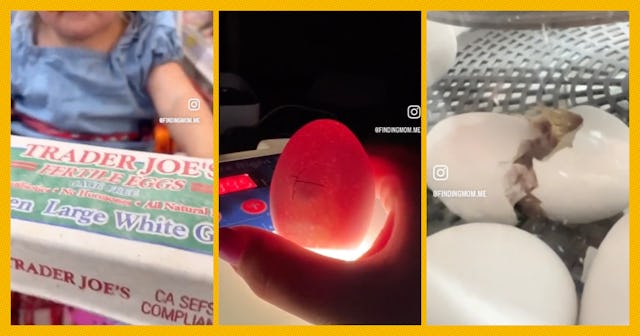TikToker Uses Fertile Trader Joe's Eggs To Hatch Live Chickens
Note to self: Check egg carton before purchasing.

A woman is going viral on TikTok after purchasing a dozen fertilized eggs from grocery store chain Trader Joe’s, taking them home, and literally hatching baby chicks.
TikTok creator Rachel Anne (@findingmom.me) recently posted a viral video that shows her hatching chicks from a dozen eggs she purchased Trader Joe’s.
In the video, Rachel places each egg in an at-home incubator. As time passes, she shines a light on one egg, showing movement inside the shell. The next clip features one of the eggs cracking with a chick hatching.
The video ends with two fluffy, adorable yellow baby birds fresh from the eggs she literally purchased from the egg section at the store.
“I’ve always wanted to do this and finally did it!! Four babies so far, four eggs still in the incubator! Meet Jo, Josie, TJ, and JoJo 😂🤪,” she wrote in the caption on the now viral video that racked up over 6 million views and more than 540,000 likes in a week.
One commenter wrote, “I ran to my fridge to make sure I didn’t buy fertile eggs.”
“Why would you do this to me?,” another comment read.
“Welp, I already on the fence about eating eggs. That was it for me,” someone joked.
“I work at Trader Joe’s and when people buy these I always ask if (they’re) doing this,” one viewer chimed in.
Does Trader Joe’s sell fertile eggs?
Rachel uploaded a few follow-up videos, answering viewers’ questions about her experience hatching the fertilized Trader Joe’s eggs.
She explained that she prefers to buy eggs from free-range hens because they’re raised in better conditions and eat better food. Some farmers introduce a rooster into their flocks when raising chickens.
When a rooster enters the coop, the eggs laid by the hens might become fertilized and sold to stores like Trader Joe’s. She also noted that if you eat fertilized eggs, you won’t taste a difference.
She shares, “Now does that mean you're eating baby chicks? No, because [farmers] collect the eggs daily. The eggs are immediately refrigerated, therefore the production and the development of the little tiny embryo has not started, and until it starts to be at 99.5 degrees for consistently many many hours, it doesn't develop.”
As a person who has raised chickens before, she also encourages buyers who are curious about raising and hatching fertilized eggs to do their research before trying to hatch chicks from store-bought eggs.
“These are live animals,” she says.
Though, yes, there can be fertile eggs sold at the grocery stores. Most eggs available for consumption cannot be hatched.
According to Science Focus, most commercial farms are required to have only female flocks, as male chickens are not necessary for hens to produce eggs. The birds are separated by gender when they are about one day old and are never put back together: the females are used for eggs, and most males are sent to slaughter. Because of this, logically, the eggs aren't fertilized and therefore can never develop into an embryo.
How to hatch fertile chicken eggs
If your curiosity has been peaked considering that getting your hands on some fertile chicken eggs is as easy as a grocery stop, here’s a step-by-step process for hatching fertile eggs at home.
First, set up the incubator, like Rachel did in the viral TikTok video. With pricier incubators, you put in an egg, close the door and out pops the chick three weeks later. However, if you’re going the DYI route, you’ll need some sort of insulated box and heat lamp.
Next, incubate the fertilized eggs by keeping tabs on temperature and humidity, making adjustments as necessary to create the optimal environment.
Lastly, watch the eggs hatch. The chick will eventually begin got peck a small hole in the large end of the egg and take its first breath. Resist the urge to help the chick break free. It’s normal for the baby chick to rest for six to 12 hours while its lungs adjust.